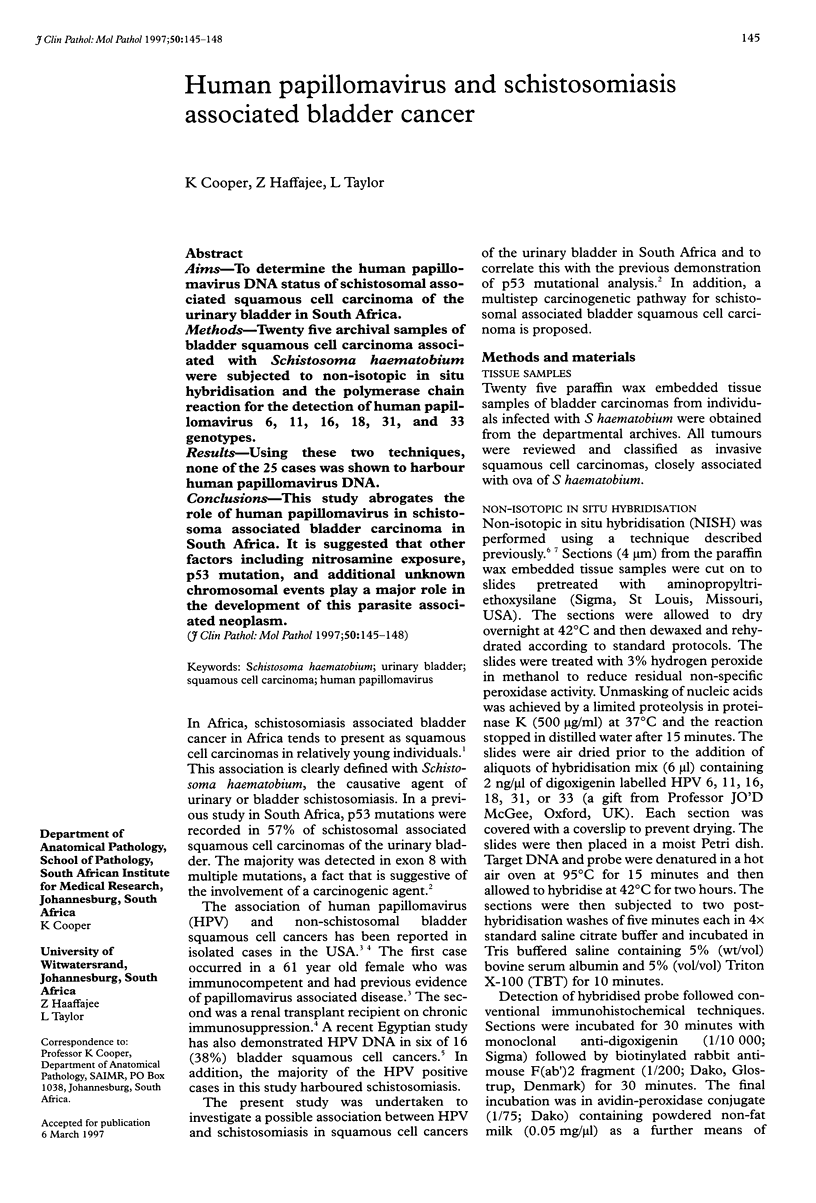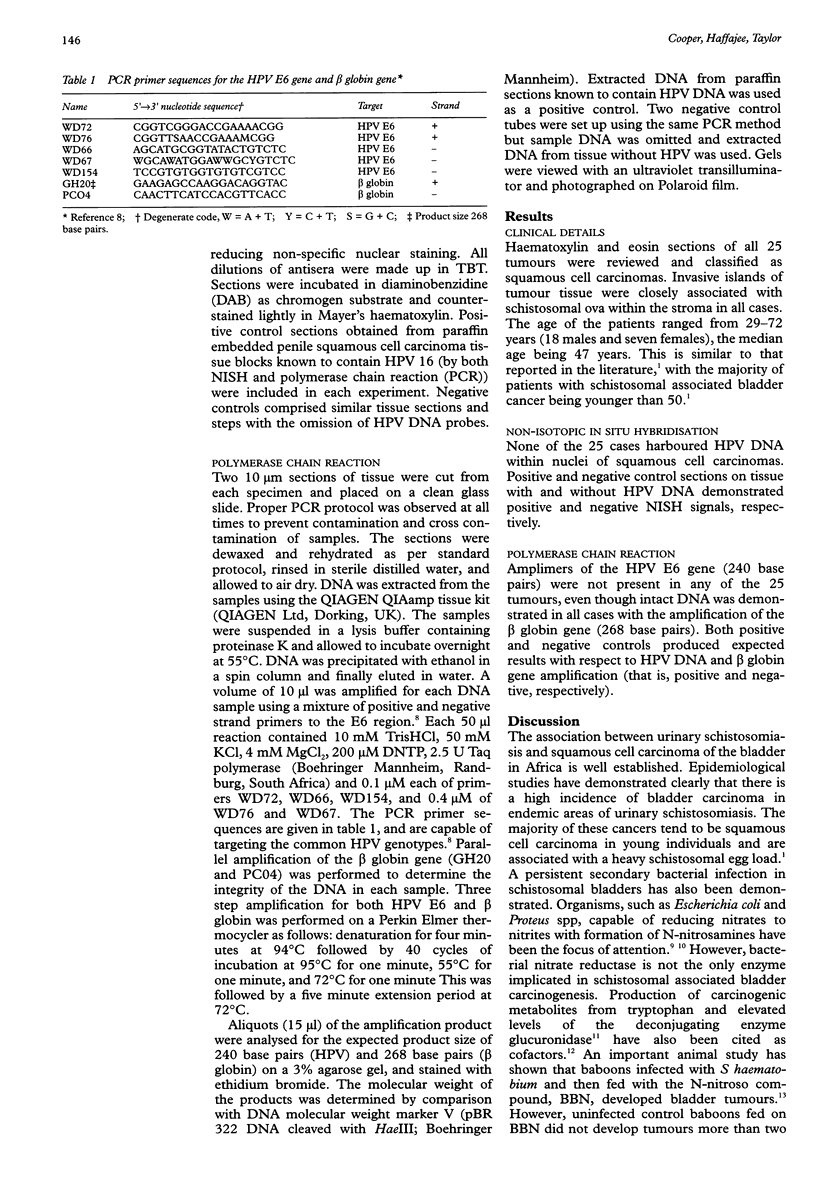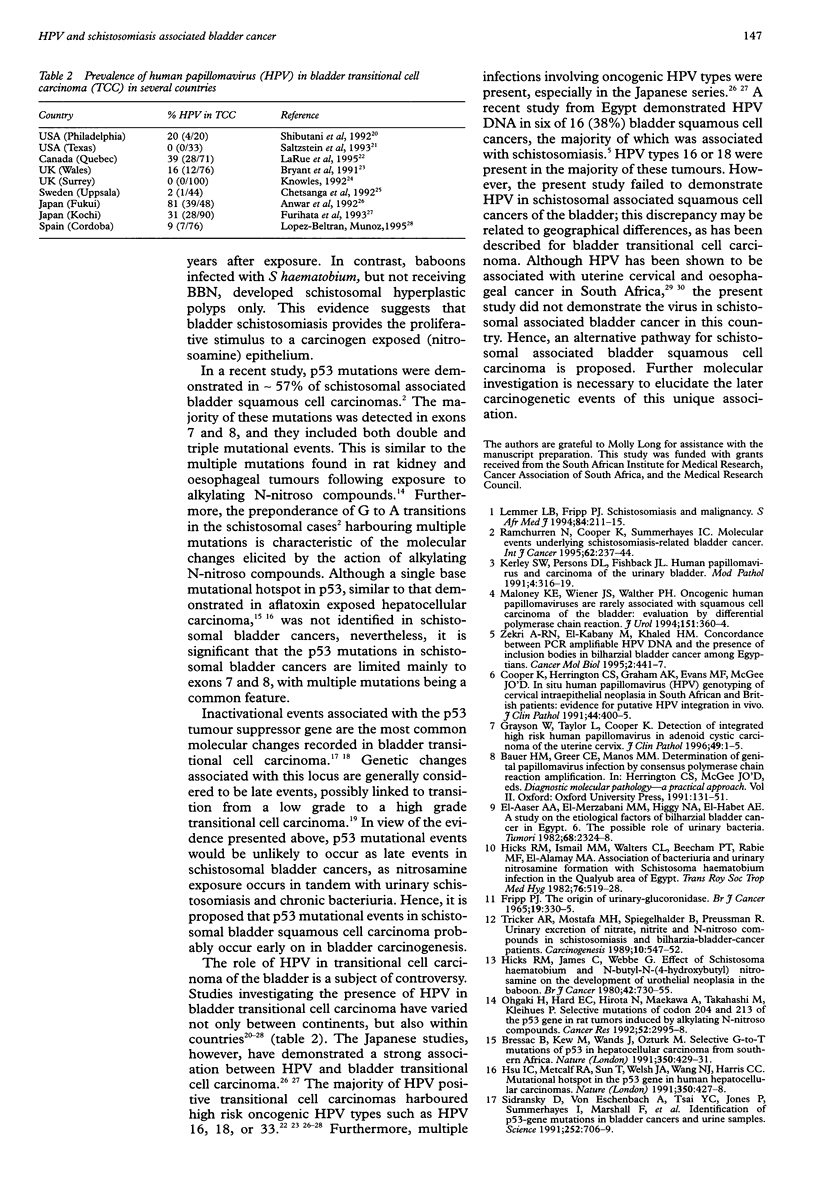Abstract
AIMS: To determine the human papillomavirus DNA status of schistosomal associated squamous cell carcinoma of the urinary bladder in South Africa. METHODS: Twenty five archival samples of bladder squamous cell carcinoma associated with Schistosoma haematobium were subjected to non-isotopic in situ hybridisation and the polymerase chain reaction for the detection of human papillomavirus 6, 11, 16, 18, 31, and 33 genotypes. RESULTS: Using these two techniques, none of the 25 cases was shown to harbour human papillomavirus DNA. CONCLUSIONS: This study abrogates the role of human papillomavirus in schistosoma associated bladder carcinoma in South Africa. It is suggested that other factors including nitrosamine exposure, p53 mutation, and additional unknown chromosomal events play a major role in the development of this parasite associated neoplasm.
Full text
PDF



Selected References
These references are in PubMed. This may not be the complete list of references from this article.
- Anwar K., Naiki H., Nakakuki K., Inuzuka M. High frequency of human papillomavirus infection in carcinoma of the urinary bladder. Cancer. 1992 Oct 1;70(7):1967–1973. doi: 10.1002/1097-0142(19921001)70:7<1967::aid-cncr2820700726>3.0.co;2-8. [DOI] [PubMed] [Google Scholar]
- Bressac B., Kew M., Wands J., Ozturk M. Selective G to T mutations of p53 gene in hepatocellular carcinoma from southern Africa. Nature. 1991 Apr 4;350(6317):429–431. doi: 10.1038/350429a0. [DOI] [PubMed] [Google Scholar]
- Bryant P., Davies P., Wilson D. Detection of human papillomavirus DNA in cancer of the urinary bladder by in situ hybridisation. Br J Urol. 1991 Jul;68(1):49–52. doi: 10.1111/j.1464-410x.1991.tb15256.x. [DOI] [PubMed] [Google Scholar]
- Chetsanga C., Malmström P. U., Gyllensten U., Moreno-Lopez J., Dinter Z., Pettersson U. Low incidence of human papillomavirus type 16 DNA in bladder tumor detected by the polymerase chain reaction. Cancer. 1992 Mar 1;69(5):1208–1211. doi: 10.1002/cncr.2820690523. [DOI] [PubMed] [Google Scholar]
- Cooper K., Herrington C. S., Graham A. K., Evans M. F., McGee J. O. In situ evidence for HPV 16, 18, 33 integration in cervical squamous cell cancer in Britain and South Africa. J Clin Pathol. 1991 May;44(5):406–409. doi: 10.1136/jcp.44.5.406. [DOI] [PMC free article] [PubMed] [Google Scholar]
- Cooper K., Herrington C. S., Graham A. K., Evans M. F., McGee J. O. In situ human papillomavirus (HPV) genotyping of cervical intraepithelial neoplasia in South African and British patients: evidence for putative HPV integration in vivo. J Clin Pathol. 1991 May;44(5):400–405. doi: 10.1136/jcp.44.5.400. [DOI] [PMC free article] [PubMed] [Google Scholar]
- Cooper K., Taylor L., Govind S. Human papillomavirus DNA in oesophageal carcinomas in South Africa. J Pathol. 1995 Mar;175(3):273–277. doi: 10.1002/path.1711750304. [DOI] [PubMed] [Google Scholar]
- FRIPP P. J. THE ORIGIN OF URINARY BETA-GLUCURONIDASE. Br J Cancer. 1965 Jun;19:330–335. doi: 10.1038/bjc.1965.38. [DOI] [PMC free article] [PubMed] [Google Scholar]
- Fujimoto K., Yamada Y., Okajima E., Kakizoe T., Sasaki H., Sugimura T., Terada M. Frequent association of p53 gene mutation in invasive bladder cancer. Cancer Res. 1992 Mar 15;52(6):1393–1398. [PubMed] [Google Scholar]
- Furihata M., Inoue K., Ohtsuki Y., Hashimoto H., Terao N., Fujita Y. High-risk human papillomavirus infections and overexpression of p53 protein as prognostic indicators in transitional cell carcinoma of the urinary bladder. Cancer Res. 1993 Oct 15;53(20):4823–4827. [PubMed] [Google Scholar]
- Hicks R. M., Ismail M. M., Walters C. L., Beecham P. T., Rabie M. F., El Alamy M. A. Association of bacteriuria and urinary nitrosamine formation with Schistosoma haematobium infection in the Qalyub area of Egypt. Trans R Soc Trop Med Hyg. 1982;76(4):519–527. doi: 10.1016/0035-9203(82)90153-5. [DOI] [PubMed] [Google Scholar]
- Hicks R. M., James C., Webbe G. Effect of Schistosoma haematobium and N-butyl-N-(4-hydroxybutyl)nitrosamine on the development of urothelial neoplasia in the baboon. Br J Cancer. 1980 Nov;42(5):730–755. doi: 10.1038/bjc.1980.308. [DOI] [PMC free article] [PubMed] [Google Scholar]
- James D. S., Leadbeatter S. Confidentiality, death and the doctor. J Clin Pathol. 1996 Jan;49(1):1–4. doi: 10.1136/jcp.49.1.1. [DOI] [PMC free article] [PubMed] [Google Scholar]
- Kerley S. W., Persons D. L., Fishback J. L. Human papillomavirus and carcinoma of the urinary bladder. Mod Pathol. 1991 May;4(3):316–319. [PubMed] [Google Scholar]
- Knowles M. A. Human papillomavirus sequences are not detectable by Southern blotting or general primer-mediated polymerase chain reaction in transitional cell tumours of the bladder. Urol Res. 1992;20(4):297–301. doi: 10.1007/BF00300263. [DOI] [PubMed] [Google Scholar]
- LaRue H, Simoneau M, Fradet Y. Human papillomavirus in transitional cell carcinoma of the urinary bladder. Clin Cancer Res. 1995 Apr;1(4):435–440. [PubMed] [Google Scholar]
- Lemmer L. B., Fripp P. J. Schistosomiasis and malignancy. S Afr Med J. 1994 Apr;84(4):211–215. [PubMed] [Google Scholar]
- Lopez-Beltran A., Muñoz E. Transitional cell carcinoma of the bladder: low incidence of human papillomavirus DNA detected by the polymerase chain reaction and in situ hybridization. Histopathology. 1995 Jun;26(6):565–569. doi: 10.1111/j.1365-2559.1995.tb00276.x. [DOI] [PubMed] [Google Scholar]
- Maloney K. E., Wiener J. S., Walther P. J. Oncogenic human papillomaviruses are rarely associated with squamous cell carcinoma of the bladder: evaluation by differential polymerase chain reaction. J Urol. 1994 Feb;151(2):360–364. doi: 10.1016/s0022-5347(17)34949-2. [DOI] [PubMed] [Google Scholar]
- Ohgaki H., Hard G. C., Hirota N., Maekawa A., Takahashi M., Kleihues P. Selective mutation of codons 204 and 213 of the p53 gene in rat tumors induced by alkylating N-nitroso compounds. Cancer Res. 1992 May 15;52(10):2995–2998. [PubMed] [Google Scholar]
- Ramchurren N., Cooper K., Summerhayes I. C. Molecular events underlying schistosomiasis-related bladder cancer. Int J Cancer. 1995 Jul 28;62(3):237–244. doi: 10.1002/ijc.2910620302. [DOI] [PubMed] [Google Scholar]
- Saltzstein D. R., Orihuela E., Kocurek J. N., Payne D. A., Chan T. S., Tyring S. K. Failure of the polymerase chain reaction (PCR) to detect human papilloma virus (HPV) in transitional cell carcinoma of the bladder. Anticancer Res. 1993 Mar-Apr;13(2):423–425. [PubMed] [Google Scholar]
- Sidransky D., Von Eschenbach A., Tsai Y. C., Jones P., Summerhayes I., Marshall F., Paul M., Green P., Hamilton S. R., Frost P. Identification of p53 gene mutations in bladder cancers and urine samples. Science. 1991 May 3;252(5006):706–709. doi: 10.1126/science.2024123. [DOI] [PubMed] [Google Scholar]
- Tricker A. R., Mostafa M. H., Spiegelhalder B., Preussmann R. Urinary excretion of nitrate, nitrite and N-nitroso compounds in Schistosomiasis and bilharzia bladder cancer patients. Carcinogenesis. 1989 Mar;10(3):547–552. doi: 10.1093/carcin/10.3.547. [DOI] [PubMed] [Google Scholar]


